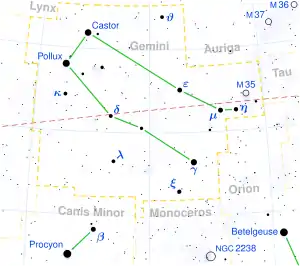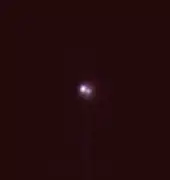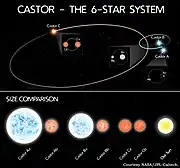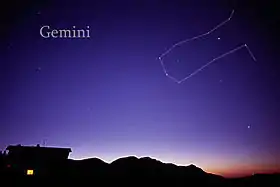Castor (star)
Castor is the second-brightest object in the zodiac constellation of Gemini and one of the brightest stars in the night sky. It has the Bayer designation α Geminorum, which is Latinised to Alpha Geminorum and abbreviated Alpha Gem or α Gem. It appears singular to the naked eye, but it is actually a sextuple star system organized into three binary pairs, made up of the stars Castor Aa, Castor Ab, Castor Ba, Castor Bb, Castor Ca, and Castor Cb. Although it is the 'α' (alpha) member of the constellation, it is fainter than 'β' (beta) Geminorum, Pollux.
 Castor within the constellation Gemini | |
| Observation data Epoch J2000 Equinox J2000 | |
|---|---|
| Constellation | Gemini |
| Pronunciation | /ˈkæstər/[1] |
| A | |
| Right ascension | 07h 34m 35.863s[2] |
| Declination | +31° 53′ 17.79″[2] |
| Apparent magnitude (V) | 1.93[2] |
| B | |
| Right ascension | 07h 34m 36.100s[2] |
| Declination | +31° 53′ 18.57″[2] |
| Apparent magnitude (V) | 2.97[2] |
| C | |
| Right ascension | 07h 34m 37.584s[2] |
| Declination | +31° 53′ 17.8160″[2] |
| Apparent magnitude (V) | 9.83[2] |
| Characteristics | |
| A | |
| Spectral type | A1V + dM1e[3] |
| B−V color index | +0.03[4] |
| B | |
| Spectral type | Am + dM1e[3] |
| B−V color index | +0.04[4] |
| C | |
| Spectral type | dM1e + dM1e[3] |
| U−B color index | +1.04[5] |
| B−V color index | +1.49[5] |
| Variable type | BY Dra[6] |
| Astrometry | |
| AB | |
| Radial velocity (Rv) | 5.40[7] km/s |
| Proper motion (μ) | RA: –191.45[8] mas/yr Dec.: –145.19[8] mas/yr |
| Parallax (π) | 64.12 ± 3.75[8] mas |
| Distance | 51 ± 3 ly (15.6 ± 0.9 pc) |
| Absolute magnitude (MV) | +0.986 / +1.886[4] |
| C | |
| Radial velocity (Rv) | +2.5[9] km/s |
| Proper motion (μ) | RA: –201.490[10] mas/yr Dec.: –97.104[10] mas/yr |
| Parallax (π) | 66.2323 ± 0.0511[10] mas |
| Distance | 49.24 ± 0.04 ly (15.10 ± 0.01 pc) |
| Absolute magnitude (MV) | +8.950[11] |
| Details | |
| α Geminorum Aa | |
| Mass | 2.76[12] M☉ |
| Radius | 2.4[13] R☉ |
| Surface gravity (log g) | 4.2[13] cgs |
| Temperature | 10,286[14] K |
| Metallicity [Fe/H] | 0.98[14] dex |
| Rotational velocity (v sin i) | 18[15] km/s |
| α Geminorum Ba | |
| Mass | 2.98[12] M☉ |
| Radius | 3.3[13] R☉ |
| Surface gravity (log g) | 4.0[13] cgs |
| Temperature | 8,842[14] K |
| Rotational velocity (v sin i) | 33[15] km/s |
| α Geminorum Ca/Cb (components are identical) | |
| Mass | 0.5992[11] M☉ |
| Radius | 0.6191[11] R☉ |
| Luminosity | 0.0733[11] L☉ |
| Surface gravity (log g) | 4.6317[11] cgs |
| Temperature | 3,820[11] K |
| Metallicity [Fe/H] | ~0.0[11] dex |
| Rotational velocity (v sin i) | 37[11] km/s |
| Age | 370[11] Myr |
| Orbit[16] | |
| Primary | α Geminorum A |
| Companion | α Geminorum B |
| Period (P) | 445[12] yr |
| Semi-major axis (a) | 7.369″ |
| Eccentricity (e) | 0.360 |
| Inclination (i) | 112.9° |
| Longitude of the node (Ω) | 41.7° |
| Periastron epoch (T) | 2401950.650 |
| Argument of periastron (ω) (secondary) | 239.8° |
| Orbit[16] | |
| Primary | α Geminorum Aa |
| Companion | α Geminorum Ab |
| Period (P) | 9.2128 days |
| Eccentricity (e) | 0.5 |
| Periastron epoch (T) | 2427543.938 |
| Argument of periastron (ω) (primary) | 266.4° |
| Semi-amplitude (K1) (primary) | 12.9 km/s |
| Orbit[16] | |
| Primary | α Geminorum Ba |
| Companion | α Geminorum Bb |
| Period (P) | 2.9283 days |
| Periastron epoch (T) | 2427501.703 |
| Argument of periastron (ω) (primary) | 94.7° |
| Semi-amplitude (K1) (primary) | 31.9 km/s |
| Orbit[16] | |
| Primary | α Geminorum AB |
| Companion | α Geminorum C |
| Period (P) | 14,000 yr |
| Semi-amplitude (K1) (primary) | 121.0 km/s |
| Semi-amplitude (K2) (secondary) | 119.0 km/s |
| Orbit[11] | |
| Primary | α Geminorum Ca |
| Companion | α Geminorum Cb |
| Period (P) | 0.814 days |
| Eccentricity (e) | 0 |
| Inclination (i) | 86.29 ± 0.10° |
| Longitude of the node (Ω) | 7.315° |
| Other designations | |
| A: BD+32°1581A, PLX 1785.00, HR 2891, HD 60179 | |
| B: BD+32°1581B, HR 2890, HD 60178 | |
| C: YY Geminorum, BD+32°1582 | |
| Database references | |
| SIMBAD | data |
| Castor A | |
| Castor B | |
| Castor C (YY Gem) | |
Stellar system
| Aa | |||||||||||||||||||
| Period = 9.2128 d | |||||||||||||||||||
| Ab | |||||||||||||||||||
| Separation = 3.9″ | |||||||||||||||||||
| Ba | |||||||||||||||||||
| Period = 2.9283 d | |||||||||||||||||||
| Bb | |||||||||||||||||||
| Separation = 71″ | |||||||||||||||||||
| Ca | |||||||||||||||||||
| Period = 0.814 d | |||||||||||||||||||
| Cb | |||||||||||||||||||
Hierarchy of orbits in the Castor system[17]
Castor is a multiple star system made up of six individual stars; there are three visual components, all which are spectroscopic binaries. Appearing to the naked eye as a single star, Castor was first recorded as a double star in 1718 by James Pound, but it may have been resolved into at least two sources of light by Cassini as early as 1678. The separation between Castor A and Castor B has increased from about 2″ (2 arcseconds of angular measurement) in 1970 to about 6″ in 2017.[18][16] These two binary pairs have magnitudes of 1.9 and 3.0.
Castor Aa and Ba both have orbits of a few days with a much fainter companion.
Castor C, or YY Geminorum, was discovered to vary in brightness with a regular period. It is an eclipsing binary with additional variations due to areas of different brightness on the surface of one or both stars, as well as irregular flares.[11] The Castor C components orbit in less than a day. Castor C is believed to be in orbit around Castor AB, but with an extremely long period of several thousand years. It is 73″ distant from the bright components.[16]
The combined apparent magnitude of all six stars is +1.58.
Physical properties
Castor is 51 light-years away from Earth, determined from its large annual parallax.
The two brightest stars are both A-class main-sequence stars, more massive and brighter than the Sun. The properties of their red dwarf companions are difficult to determine, but are both thought to have less than half the mass of the Sun.[16]
Castor B is an Am star, with particularly strong spectral lines of certain metals.
Castor C is a variable star, classified as a BY Draconis type. BY Draconis variables are cool dwarf stars which vary as they rotate due to starspots or other variations in their photospheres. The two red dwarfs of Castor C are almost identical, with masses around a half M☉and luminosities less than 10% of the Sun.[11]
All the red dwarfs in the Castor system have emissions lines in their spectra, and all are flare stars.[13]
Etymology and culture
α Geminorum (Latinised to Alpha Geminorum) is the star system's Bayer designation.
Castor and Pollux are the two "heavenly twin" stars that give the constellation Gemini (meaning twins in Latin) its name. The name Castor refers specifically to Castor, one of the twin sons of Zeus and Leda in Greek and Roman mythology.
The star was annotated by the Arabic description Al-Ras al-Taum al-Muqadim, which translates as the head of the foremost twin. In the catalogue of stars in the Calendarium of Al Achsasi Al Mouakket, this star was designated Aoul al Dzira, which was translated into Latin as Prima Brachii, meaning the first in the paw.[19]
In Chinese, 北河 (Běi Hé), meaning North River, refers to an asterism consisting of Castor, ρ Geminorum, and Pollux.[20] Consequently, Castor itself is known as 北河二 (Běi Hé èr, English: the Second Star of North River.)[21]
In 2016, the International Astronomical Union organized a Working Group on Star Names (WGSN)[22] to catalog and standardize proper names for stars. The WGSN's first bulletin of July 2016 included a table of the first two batches of names approved by the WGSN; which included Castor for the star α Geminorum Aa.[23]
Castor C also has the variable star designation YY Geminorum.
Long-exposure observation
Stars that can set (not in a circumpolar constellation for the viewer) culminate at midnight – noticeable where viewed away from any polar region experiencing midnight sun – when at opposition, meaning they can be viewed from dusk until dawn. This applies to α Geminorum on 14 January, in the current astronomical epoch.[24]
Half of the year from this date, 14 July, the star will be at conjunction above or below, the sun – apart by the star's declination (angle set out in table, right). The nearby days and months have most of the star's risen time being during daylight.
 The Castor AB pair resolved
The Castor AB pair resolved Components
Components Castor is one of the two brightest stars in the constellation of Gemini (top left star).
Castor is one of the two brightest stars in the constellation of Gemini (top left star).
References
- Kunitzsch, Paul; Smart, Tim (2006). A Dictionary of Modern star Names: A Short Guide to 254 Star Names and Their Derivations (2nd rev. ed.). Cambridge, Massachusetts: Sky Pub. ISBN 978-1-931559-44-7.
- Fabricius, C.; et al. (March 2002). "The Tycho double star catalogue". Astronomy and Astrophysics. 384: 180–189. Bibcode:2002A&A...384..180F. doi:10.1051/0004-6361:20011822.
- Pourbaix, D.; Tokovinin, A. A.; Batten, A. H.; Fekel, F. C.; Hartkopf, W. I.; Levato, H.; Morrell, N. I.; Torres, G.; Udry, S. (2004). "SB9: The ninth catalogue of spectroscopic binary orbits". Astronomy and Astrophysics. 424 (2): 727–732. arXiv:astro-ph/0406573. Bibcode:2004A&A...424..727P. doi:10.1051/0004-6361:20041213. ISSN 0004-6361. S2CID 119387088.
- Barrado y Navascues, D. (1998). "The Castor moving group. The age of Fomalhaut and VEGA". Astronomy and Astrophysics. 339: 831–839. arXiv:astro-ph/9905243. Bibcode:1998A&A...339..831B.
- Ducati, J. R. (2002). "VizieR Online Data Catalog: Catalogue of Stellar Photometry in Johnson's 11-color system". CDS/ADC Collection of Electronic Catalogues. 2237: 0. Bibcode:2002yCat.2237....0D.
- Samus, N. N.; Durlevich, O. V.; et al. (2009). "VizieR Online Data Catalog: General Catalogue of Variable Stars (Samus+ 2007–2013)". VizieR On-line Data Catalog: B/GCVS. Originally Published in: 2009yCat....102025S. 1: 02025. Bibcode:2009yCat....102025S.
- Gontcharov, G. A. (November 2006). "Pulkovo Compilation of Radial Velocities for 35 495 Hipparcos stars in a common system". Astronomy Letters. 32 (11): 759–771. arXiv:1606.08053. Bibcode:2006AstL...32..759G. doi:10.1134/S1063773706110065. S2CID 119231169.
- van Leeuwen, F. (November 2007). "Validation of the new Hipparcos reduction". Astronomy and Astrophysics. 474 (2): 653–664. arXiv:0708.1752. Bibcode:2007A&A...474..653V. doi:10.1051/0004-6361:20078357. S2CID 18759600.
- Wilson, Ralph Elmer (1953). "General Catalogue of Stellar Radial Velocities". Washington. Washington: Carnegie Institution of Washington: 0. Bibcode:1953GCRV..C......0W.
- Brown, A. G. A.; et al. (Gaia collaboration) (August 2018). "Gaia Data Release 2: Summary of the contents and survey properties". Astronomy & Astrophysics. 616. A1. arXiv:1804.09365. Bibcode:2018A&A...616A...1G. doi:10.1051/0004-6361/201833051. Gaia DR2 record for this source at VizieR.
- Torres, Guillermo; Ribas, Ignasi (2002). "Absolute Dimensions of the M‐Type Eclipsing Binary YY Geminorum (Castor C): A Challenge to Evolutionary Models in the Lower Main Sequence". The Astrophysical Journal. 567 (2): 1140–1165. arXiv:astro-ph/0111167. Bibcode:2002ApJ...567.1140T. doi:10.1086/338587. ISSN 0004-637X. S2CID 16780943.
- Tokovinin, A. (September 2008). "Comparative statistics and origin of triple and quadruple stars". Monthly Notices of the Royal Astronomical Society. 389 (2): 925–938. arXiv:0806.3263. Bibcode:2008MNRAS.389..925T. doi:10.1111/j.1365-2966.2008.13613.x. S2CID 16452670.
- Stelzer, B.; Burwitz, V. (May 2003). "Castor A and Castor B resolved in a simultaneous Chandra and XMM-Newton observation". Astronomy and Astrophysics. 402 (2): 719–728. arXiv:astro-ph/0302570. Bibcode:2003A&A...402..719S. doi:10.1051/0004-6361:20030286. S2CID 15268418.
- Smith, M. A. (April 1974). "Metallicism in border regions of the Am domain. III. Analysis of the hot stars Alpha Geminorum A and B and Theta Leonis". Astrophysical Journal. 189: 101–111. Bibcode:1974ApJ...189..101S. doi:10.1086/152776.
- Royer, F.; Zorec, J.; Gómez, A. E. (February 2007). "Rotational velocities of A-type stars. III. Velocity distributions". Astronomy and Astrophysics. 463 (2): 671–682. arXiv:astro-ph/0610785. Bibcode:2007A&A...463..671R. doi:10.1051/0004-6361:20065224. S2CID 18475298.
- Tokovinin, A. A. (1997). "MSC - a catalogue of physical multiple stars". Astronomy and Astrophysics Supplement Series. 124 (1): 75–84. Bibcode:1997A&AS..124...75T. doi:10.1051/aas:1997181. ISSN 0365-0138.
- Hussain, G. A. J.; Brickhouse, N. S.; Dupree, A. K.; Reale, F.; Favata, F.; Jardine, M. M. (June 2012). "Chandra study of the eclipsing M dwarf binary, YY Gem" (PDF). Monthly Notices of the Royal Astronomical Society. 423 (1): 493−504. Bibcode:2012MNRAS.423..493H. doi:10.1111/j.1365-2966.2012.20894.x.
- Heintz, W. D. (1980). "Micrometer Observations of Double Stars and New Pairs - Part Ten". The Astrophysical Journal Supplement Series. 44: 111. Bibcode:1980ApJS...44..111H. doi:10.1086/190686. ISSN 0067-0049.
- Knobel, E. B. (June 1895). "Al Achsasi Al Mouakket, on a catalogue of stars in the Calendarium of Mohammad Al Achsasi Al Mouakket". Monthly Notices of the Royal Astronomical Society. 55 (8): 429. Bibcode:1895MNRAS..55..429K. doi:10.1093/mnras/55.8.429.
- (in Chinese) 中國星座神話, written by 陳久金. Published by 台灣書房出版有限公司, 2005, ISBN 978-986-7332-25-7.
- (in Chinese) 香港太空館 - 研究資源 - 亮星中英對照表 Archived September 29, 2009, at the Wayback Machine, Hong Kong Space Museum. Accessed on line November 23, 2010.
- "IAU Working Group on Star Names (WGSN)". Retrieved 22 May 2016.
- "Bulletin of the IAU Working Group on Star Names, No. 1" (PDF). Retrieved 28 July 2016.
- In-the-Sky.org. Dominic C. Ford, 2011–2020; Cambridge UK.